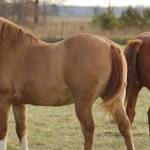New Testing Protocol for Equine Metabolic Syndrome

If you’ve ever tested a horse for insulin dysregulation (ID) using the oral glucose test (OGT), you know it can be cumbersome and sticky. To ease the burdens associated with traditional testing protocols using Karo syrup or oral dextrose, a palatable custom-made “glycemic pellet” was recently developed and determined to be “a suitable, novel carbohydrate source for the OGT.”*
Insulin dysregulation is a central feature of equine metabolic syndrome (EMS) and describes horses that have persistently elevated insulin levels. Hyperinsulinemia triggers damage to the lamella of the equine foot, contributing to the high risk of laminitis in metabolic horses.
As the name suggests, the OGT is performed by oral administration of Karo syrup or dextrose to horses and then measuring insulin and glucose values. For more details on this test, refer to the Equine Endocrinology Group’s most recent guidelines.
Certain challenges are associated with traditional versions of the test using Karo syrup or dextrose:
- Karo syrup is not available globally; and
- Dextrose has unreliable palatability. Thus, some horses require nasogastric intubation of the dextrose, or dextrose must be mixed with chaff and feed. Even this latter approach can lead to dextrose refusal, leaving the test invalid.
“Most horses with insulin dysregulation will require repeated testing to monitor disease, and use of a consistent diagnostic approach for each patient is essential,” reported the research team. “Thus, a widely available glucose product that is administered in a uniform manner to horses undergoing a glycemic challenge test is needed.”
A custom-made glycemic pellet was therefore designed, containing oligosaccharides, carbohydrate chains composed of three to ten simple sugars. To perform this version of the sugar test, horses were housed in a stall overnight with only 0.2-0.4 kg/100 kg body weight hay or haylage. In the morning, a blood sample was taken to measure baseline insulin and glucose values immediately prior to offering 0.5 g of the soluble glycemic pellet per kg body weight. Horses had access to the pellets for 10 minutes before the feed bucket was removed. Three additional blood samples were collected at 60, 90, and 120 minutes after being fed the pellets.
One hundred fifty-seven horses and ponies living in Australia, Germany, Sweden, the United Kingdom, and the United States were included in the study. Pellets were deemed to have very good or good palatability in 84.1% of the horses.
Further, median intake time of the pellets was four minutes, which was about the same rate as administering either Karo syrup using a dosing syringe or dextrose solution by a nasogastric tube.
Peak glucose and insulin blood levels were measured at 120 minutes, and an optimal diagnostic cutoff value of 83 microIU/mL at 120 minutes was established. This means that horses with insulin values above 83 microIU/mL were diagnosed with insulin dysregulation.
“This novel pellet was fairly successfully used for a glycemic challenge test to identify horses and ponies with insulin dysregulation. The pellet was palatable for most of the study subjects and consumed rapidly, making this protocol a potentially simplified version of the OGT,” explained Katie Young, Ph.D., a nutritionist for Kentucky Equine Research. “A simple, reliable test such as this is needed for monitoring horses diagnosed with insulin dysregulation to track progression of disease.”
Once diagnosed, a combination of diet modification and exercise may improve a horse’s insulin response, thereby decreasing its risk of hyperinsulinemic-associated laminitis.
According to Young, maintaining appropriate body condition, regular exercise, and controlling nonstructural carbohydrate (NSC) intake are all important components of managing insulin dysregulation in horses.
“To reduce dietary NSCs, horse owners should look for a feed formulated with low-NSC content or, for easy keepers, provide a low-intake, low-NSC ration balancer such as All-Phase. Forages can also contribute significant calories and NSCs to a diet, so horses suffering from EMS/ID may require a lower NSC hay and little to no fresh pasture,” Young advised.
If low-NSC hay is not available, soaking hay can reduce NSC content for “carb-sensitive” horses.
*de Laat, M.A., T. Warnken, J. Delarocque, D.B. Reiche, A.J. Grob, K. Feige, H.B. Carslake, A.E. Durham, M.N. Sillence, K.E. Thane, N. Frank, J. Brojer, S. Lindase, and J. Sonntag. 2023. Carbohydrate pellets to assess insulin dysregulation in horses. Journal of Veterinary Internal Medicine 37(1):302-314.








